Effective Classroom Environment for Special Needs Students
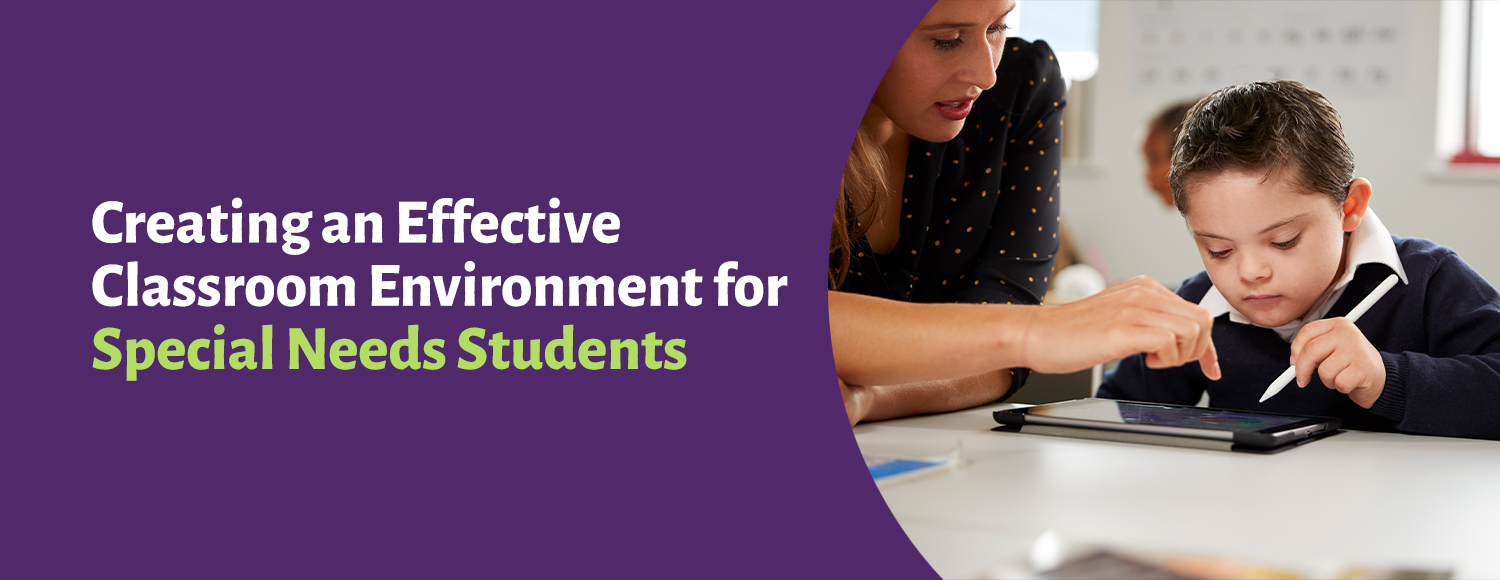
The classroom can be a peaceful place designed for focus and growth — or it could be full of distractions and problems that keep students from doing their best work. For special needs students, subtle changes to the classroom environment can make it hard to pay attention or access educational resources. You don’t need to flip your classroom upside down to help your special needs learners — even a few small changes can make a big difference.
We’ve put together a list of 15 ways you can improve a special education learning environment.
What Types of Students Benefit From a Special Needs Learning Environment?
But first, what kinds of students are we talking about? Children of all abilities can benefit from an inclusive classroom. Many of the topics we’ll be discussing are helpful for all learners, but they may have an especially strong impact on special needs students. Some will help kids move or physically do their work more easily, while others will focus on putting them in the best possible brain space. Reducing distractions or increasing predictability are a few examples of supporting students’ mental states.
Many of these strategies address sensory difficulties, which affect about one in six children. However, the prevalence can be as high as 80%-100% for some populations like children with Autism Spectrum Disorder (ASD). Attention-deficit hyperactivity disorder (ADHD) is also commonly associated with sensory difficulties. When a child has sensory issues, they may feel overstimulated or understimulated by their environment. A child might, for instance, be focused so intently on the buzzing air conditioner or the flickering light that they completely miss what the teacher was saying for the last ten minutes.
Some examples of students that can benefit from special education classrooms include those with:
- Learning disabilities.
- Hearing or visual impairments.
- A physical disability.
- Speech or language disorders.
- ASD.
- ADHD.
Of course, every child is different, but the tips we’re about to discuss tend to help kids with many types of special needs.
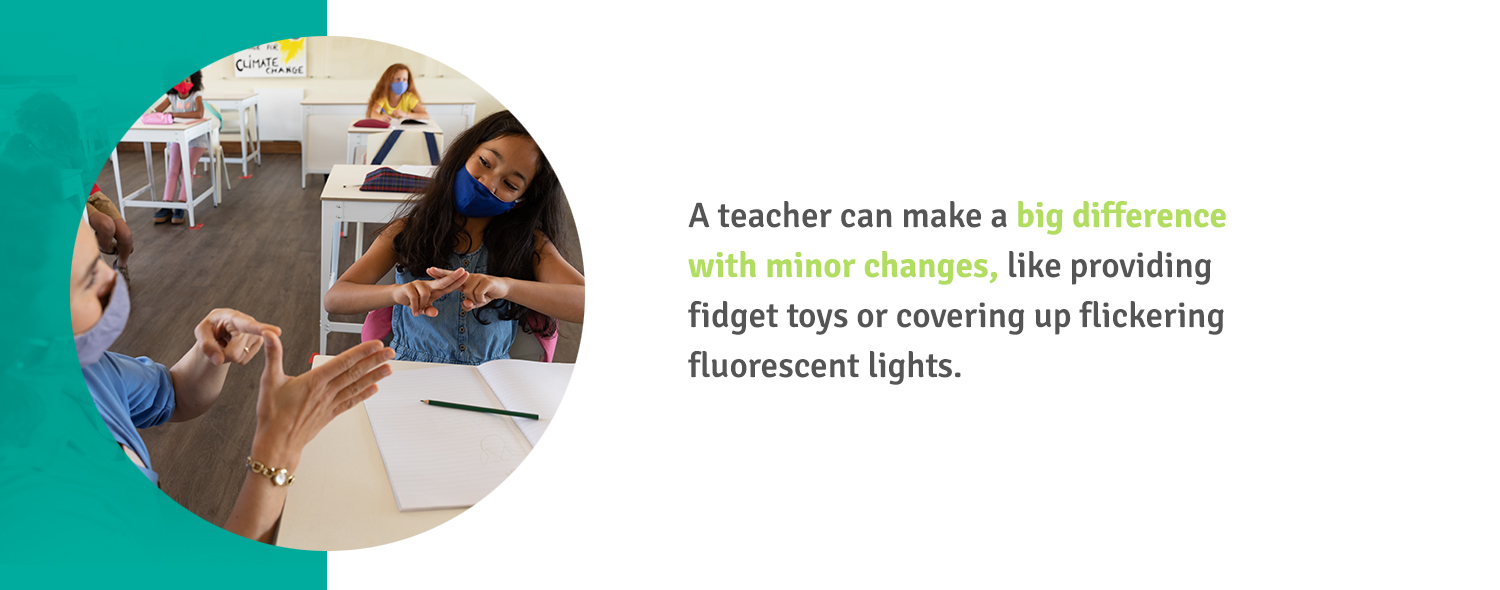
What Does a Special Education Learning Space Look Like?
Every special needs setting will look different. Classrooms specifically designed for special education might have more robust resources, like special needs seating options and a sensory space. Standard classrooms can also offer helpful tools for special needs students. A teacher can make a big difference with minor changes, like providing fidget toys or covering up flickering fluorescent lights. Many of the following suggestions are great for kids without special needs who still struggle with sensory issues.
Whatever your classroom looks like, special education spaces are versatile and often individualized to the needs of the students. When designing your space, involve the students and let them help make it great.
Ways to Improve a Special Education Learning Environment
Let’s dive into what you can do to make a special education space as helpful as possible to your learners.
1. Consider Seating and Room Layouts
Pods and circles are popular ways to set up a classroom, but they might be tricky for some students to work with. Instead, consider setting chairs up in rows, which can be useful for kids with various abilities. It can give children with physical disabilities enough space to move around, while children with autism get more space to themselves. Kids with ADHD can look forward and focus on the teacher.
Another way to change the classroom is to use alternative seating, such as stability balls, wobble stools or rocker chairs. These flexible seating solutions can help many kids keep themselves busy and get the wiggles out so they can focus on what the teacher is saying. Alternative seating might add a new dimension to classroom management, so make sure your kids can handle it first.
Lastly, the layout of the room should be logical and easy to follow. Set up “paths” for traffic flow and clearly defined zones that help children associate certain spots with certain activities. For instance, you might have a large table in the back for group work or a cozy corner for quiet time. Try using specific colors or dividers to separate your zones. The classroom layout also needs to offer enough room for kids to navigate, especially if they use wheelchairs or walkers.
2. Create a Quiet Space
What is the noise environment like in your classroom? Are there loads of distractions, like a buzzing light or student chatter from the bathroom across the hall? Students can benefit from a soothing environment, but that might look different for various students.
For instance, kids with visual impairments often need clear sound to help deliver context about the environment, while kids with hearing impairments need as little background noise as possible to understand their teachers and classmates. Try to limit distracting sounds — ask maintenance to fix that buzzing lightbulb, get in the habit of shutting your door or install acoustic panels to dampen sounds.
Kids with sensory difficulties can similarly benefit from reducing distracting noises, but they may need some kind of background noise to reach the right level of stimulation. White noise or soft, relaxing music can do the trick. Consider allowing them to listen to music through one headphone if your other students aren’t interested in the sounds.
3. Remove Visual Clutter and Distractions
Although fun, bright colors on the wall might seem like they’d keep kids engaged, they sometimes do the opposite. Studies have found less on-task behavior in classrooms with more visual noise and color variability, as well as in classrooms with a small or large number of displays. In other words, there’s a sweet spot when it comes to classroom decor.
Too much clutter can create distractions, especially for kids with ASD or ADHD. You want to aim for neutral-colored walls and use bright colors only to draw attention to important things, like your classroom rules or the date. Make sure nothing clashes or is too flashy.
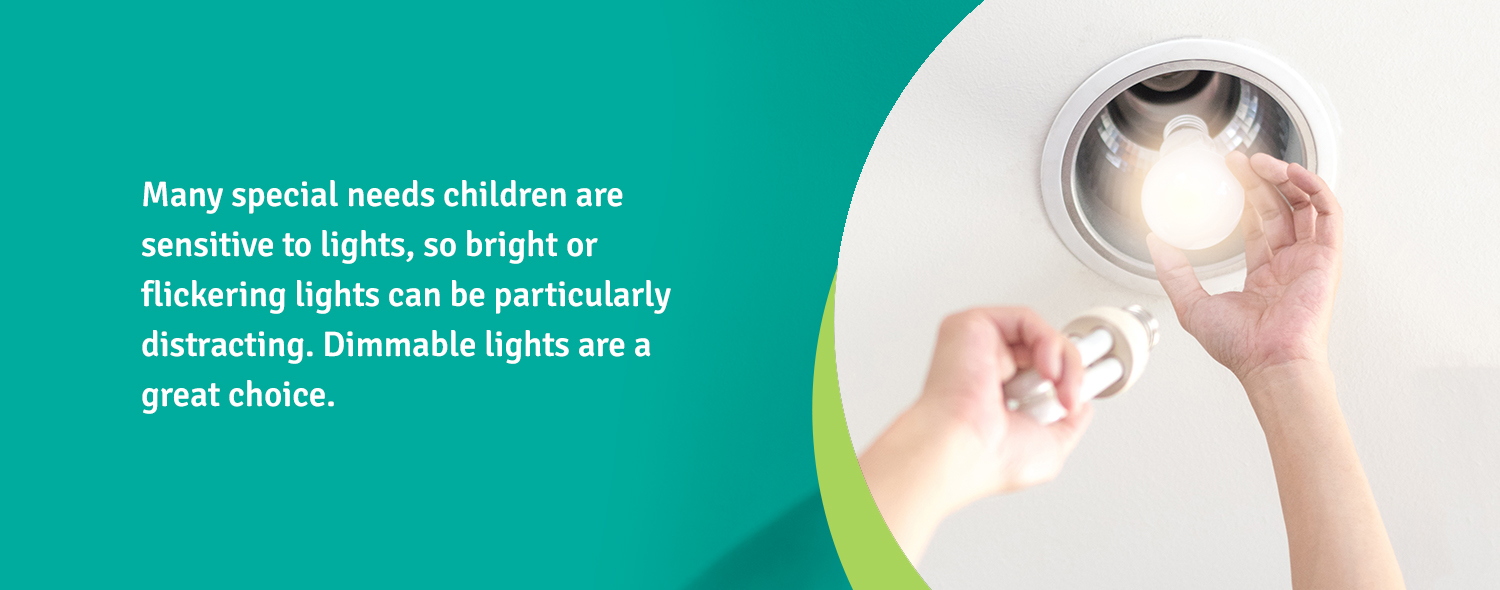
4. Adjust the Lighting
The lighting in your classroom can also make a big difference in how your students learn. The best lighting is usually natural light, but of course, that isn’t always available. Non-fluorescent lighting can be easier on the eyes, but you can also add fluorescent light filters to reduce glare and diffuse the light from these sources.
Many special needs children are sensitive to lights, so bright or flickering lights can be particularly distracting. Dimmable lights are a great choice. They allow you to adjust the lighting throughout the day according to the needs of your classroom. Are your kids getting a little overstimulated? Dim the lights for a quick pause.
Studies have even illustrated that adjusting lighting levels throughout the day helps students be more engaged. The researchers also found that high color temperatures — cooler temperatures that mimic daylight, as opposed to the warm light from a candle — positively impacted student alertness, energy and attitude.
5. Adapt Your Furniture
Some kids might struggle with traditionally designed classroom furniture, particularly those with physical disabilities or orthopedic problems. Consider making changes to the height of the seats or changing their writing surface with handwriting aids like grips and slant boards. Try adding large pegs to items like coat hooks and door handles to help children with reduced fine motor skills.
6. Keep a Comfortable Temperature
Even the temperature can play a role in student learning. Research has indicated that the ideal learning environment is below 22 degrees Celsius or about 71 degrees Fahrenheit. In fact, when temperatures were reduced from 30 degrees to 20 degrees Celsius, students’ performance on psychological tests and school tasks increased by about 20%.
Teachers may not always have direct control over the temperature of their classrooms, but other solutions, like fans and window shades, can help keep the temperature in the right range.
7. Promote Ownership in the Space
Pride in their space can help students feel more comfortable. You can cultivate a sense of ownership by allowing students to help design the room or designate the classroom zones. Put some student work on the walls, but remember not to clutter the space.
8. Offer Fidget Toys
Fidgets or fidget toys allow kids with ADHD and other sensory difficulties to achieve the right level of stimulation without affecting others. When students deliberately engage a secondary sense while working on another task, they can improve performance. One researcher even found the principle of these physical activities is similar to how ADHD medications work. Many children without ADHD benefit from fidgets, too.
Fidget toys are generally non-disruptive, so you don’t need to worry about distracting other students. You can choose from a wide variety of fidget toys and keep them somewhere students can use them during regular class time.
9. Maintain Predictability
Children with ASD don’t often respond well to change, so maintaining a predictable routine can help them significantly. It’s also valuable for other special needs children, who often benefit from regularity. It can make them feel more secure, understand the expectations and minimize behavior issues. It can also help you by allowing you to make plans further in advance.
Follow a schedule and keep it somewhere they can see it. If the schedule needs to change, such as for field trips, fire drills or guest speakers, be sure to give the students plenty of warning and return to your schedule as soon as possible.
You can also help students predict the classroom environment and understand expectations by clarifying your classroom rules. Consider having students help create the rules, which also allows them to take more ownership in the classroom environment. Post the rules in a prominent location and practice going over them. You might have students take turns reading the rules aloud and then discuss the consequences of breaking one.
10. Incorporate Break Times
Break times can help overstimulated students relax. Try working some quiet time into the school day with stories, stretching or a deep-breathing session. Some of these break options can also help students learn more self-regulation, which can be useful for children with behavioral issues.
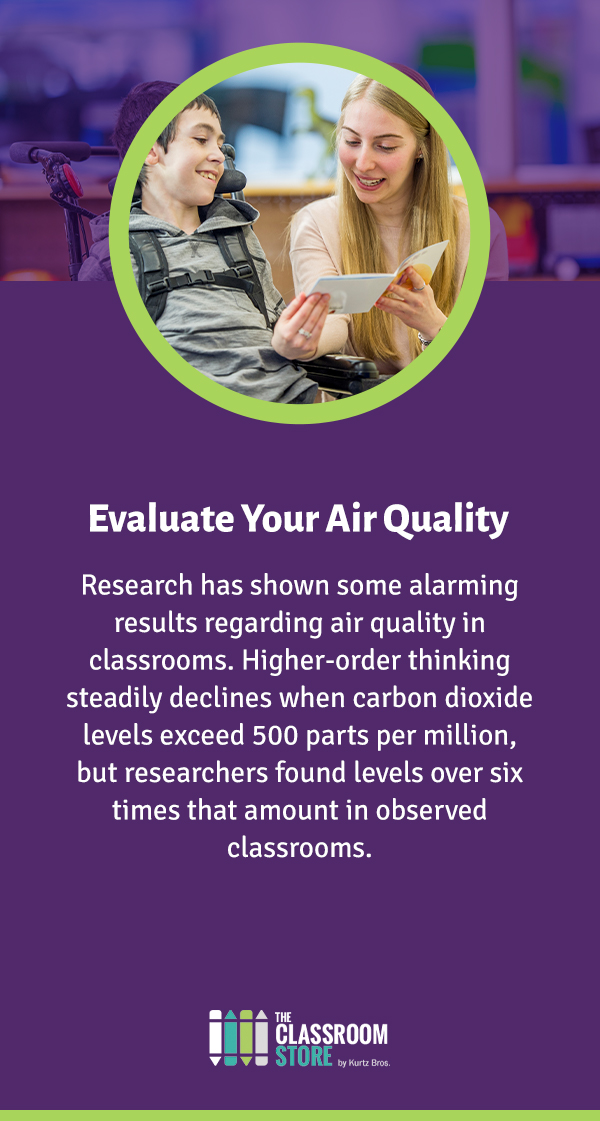
11. Evaluate Your Air Quality
Research has shown some alarming results regarding air quality in classrooms. Higher-order thinking steadily declines when carbon dioxide levels exceed 500 parts per million, but researchers found levels over six times that amount in observed classrooms. Since carbon dioxide is produced when we breathe, a classroom can quickly lose air quality, even if class starts at a healthy level.
To combat these findings, teachers can try to open windows and doors or turn on fans to help with the airflow. Air quality might be hard to detect, but it can make a difference in student learning.
12. Offer Visual Supports
Many special needs students have an easier time understanding visual cues. Try adding pictures where appropriate in the classroom, such as a picture of someone shushing above the quiet zone or a picture of a toilet by your restroom pass. Even older students can benefit from some of these visual cues.
13. Implement Technology
Many students focus better with the novelty and excitement of technology, especially children with autism. If you have access to electronics, such as tablets or laptops, try incorporating educational games and electronic formats. Kids can learn in a more engaging way while building up some technical skills. Children with reading disabilities can use text-to-speech apps, while students with motor impairments can work on their coordination. Many apps are even designed specifically for children with certain disabilities or disorders.
14. Individualize the Class for IEPs
Review your special needs students’ IEPs and see if you can make things easier on them. For instance, if a student has an augmented and alternative communication (AAC) device that will take up desk space, you might want to seat them at a larger table so they have more room for their work. If you have a student with visual impairments, you could get some tactile sensory toys or light panels.
15. Create a Sensory Space
Many kids can benefit from a sensory space, which includes objects that appeal to different senses, including movement. A sensory space is often a quiet, secluded area such as a tent or a fort filled with various sensory elements, like headphones and music players, sensory toys and weighted blankets. You might also include a Sensory Sack or a Cocoon Climbing Swing they can use to decompress.
Sensory spaces are a great way to help kids calm down after being overstimulated by their environment. They can be beneficial for students with ASD, ADHD or behavioral problems.
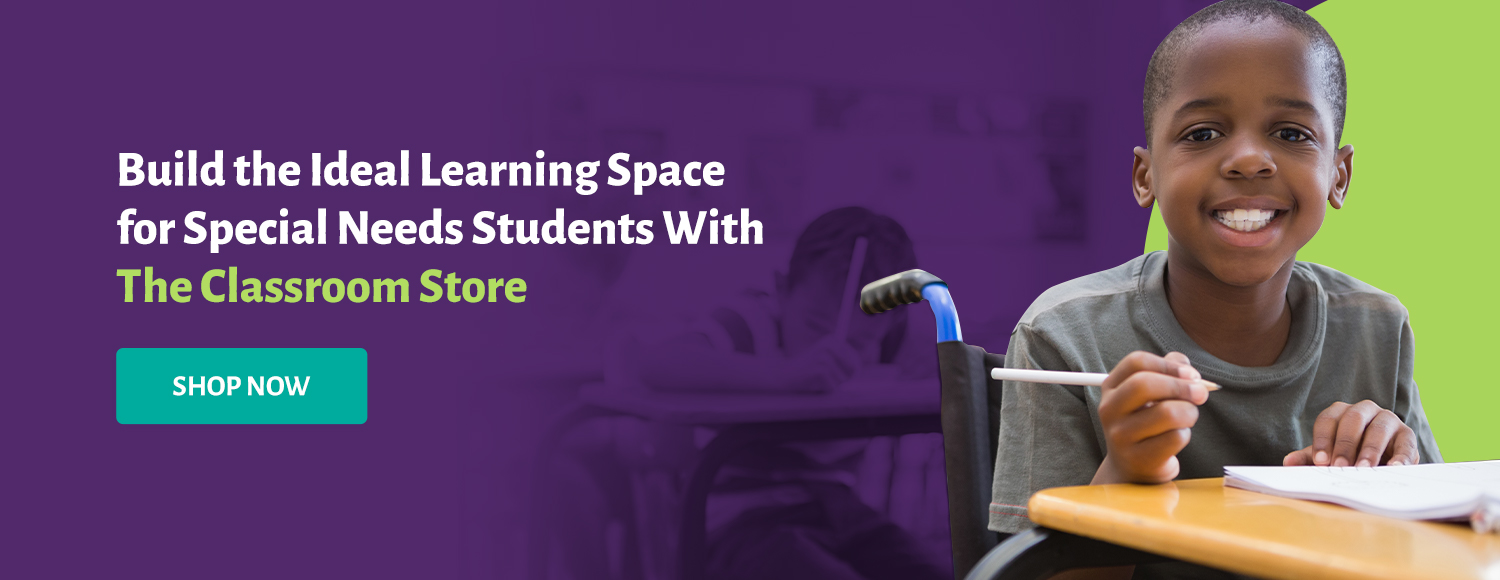
Build the Ideal Learning Space for Special Needs Students With The Classroom Store
No two classrooms are the same, so building an effective special needs learning space calls for access to a unique selection of items. At The Classroom Store, you’ll find just that. From calming toys and weighted clothing to alternative seating options, you can choose the tools that work best for your learners and cultivate a welcoming, engaging setting.
The Classroom Store carries education supplies for students from early childhood to graduation, so whether your special education classroom is built for little ones or high schoolers, our collection of quality products can help. Explore products for special needs students online, or reach out to us with any questions!

